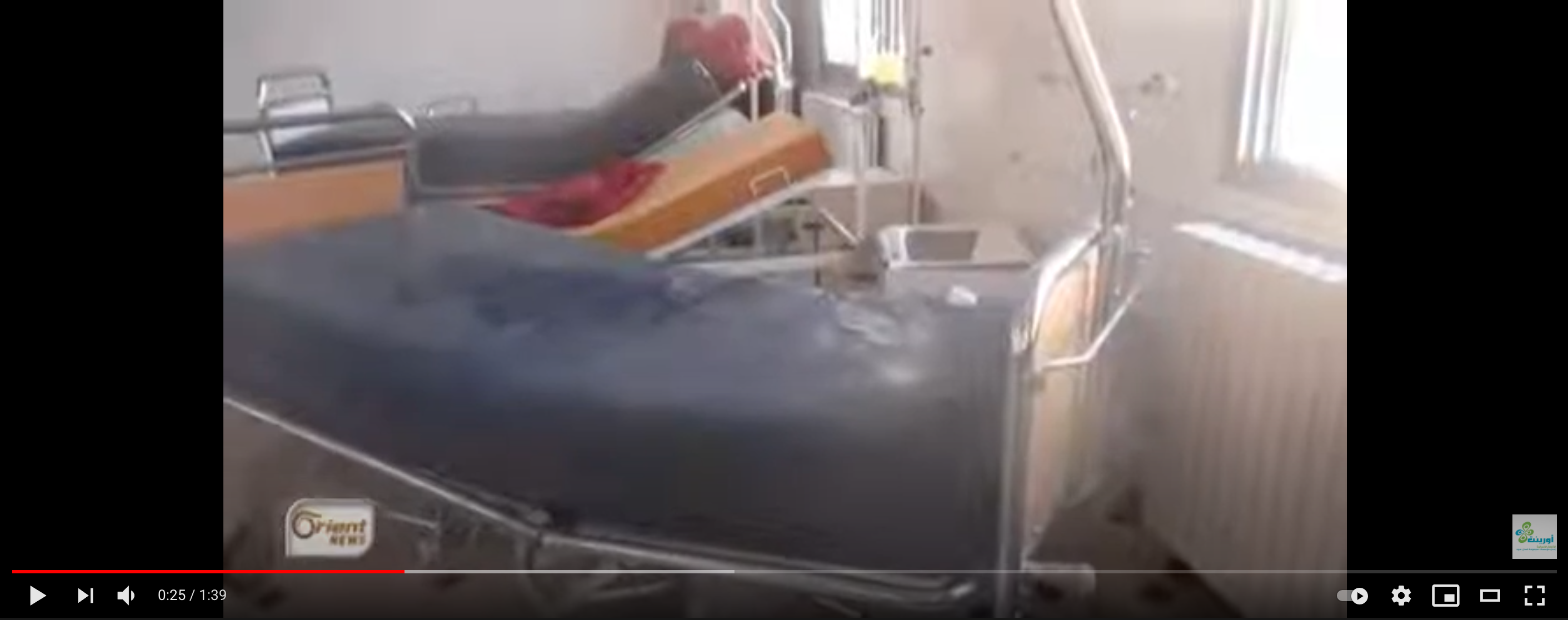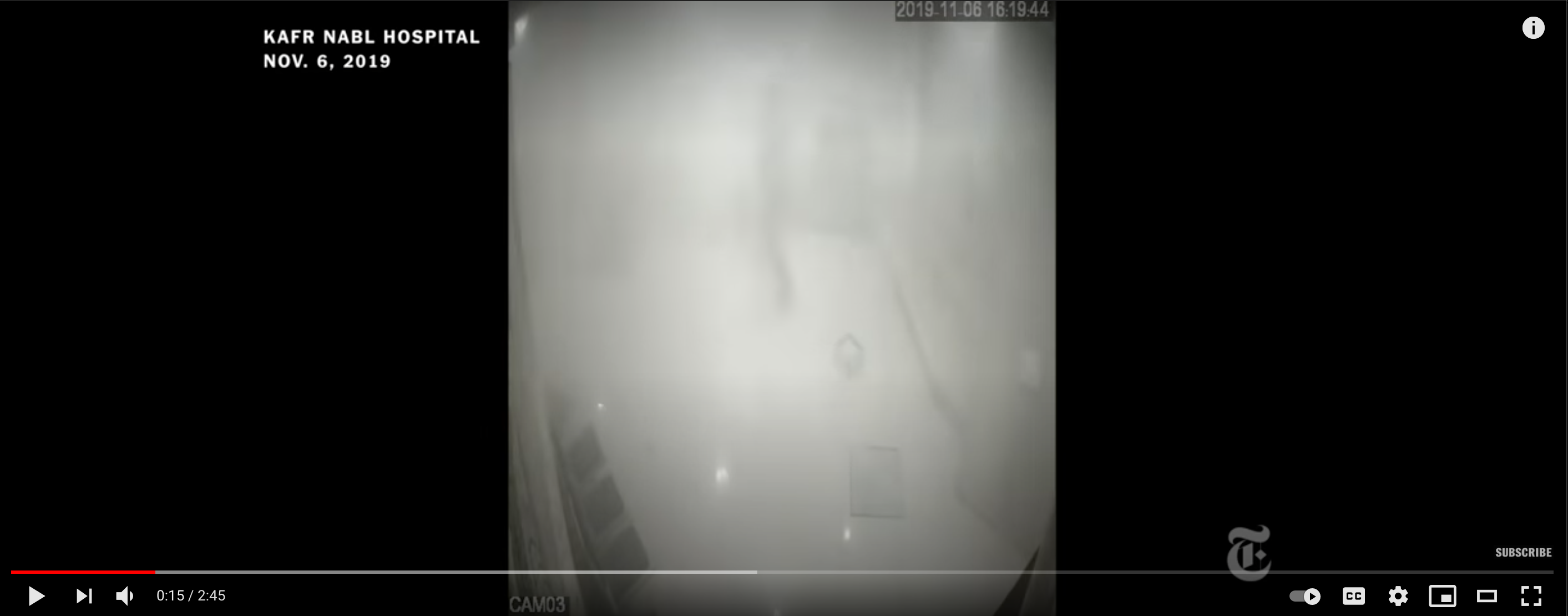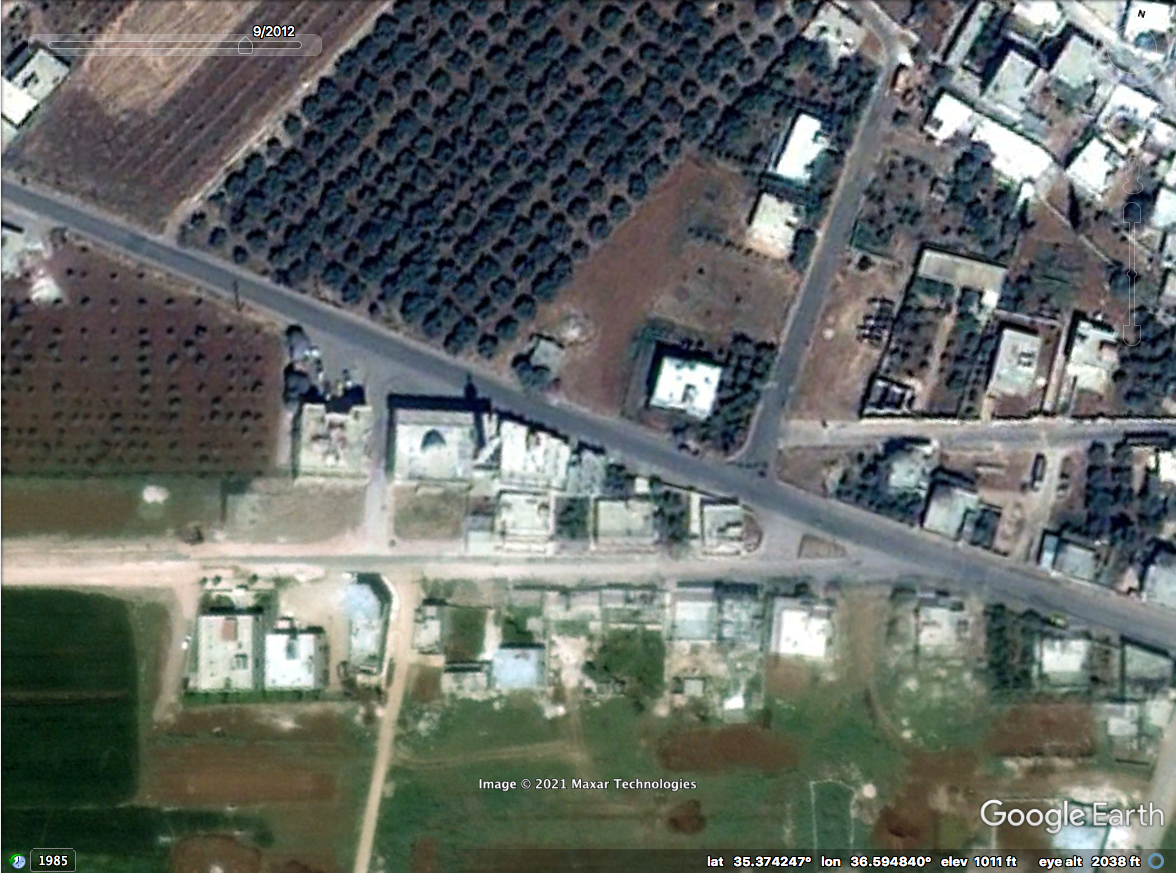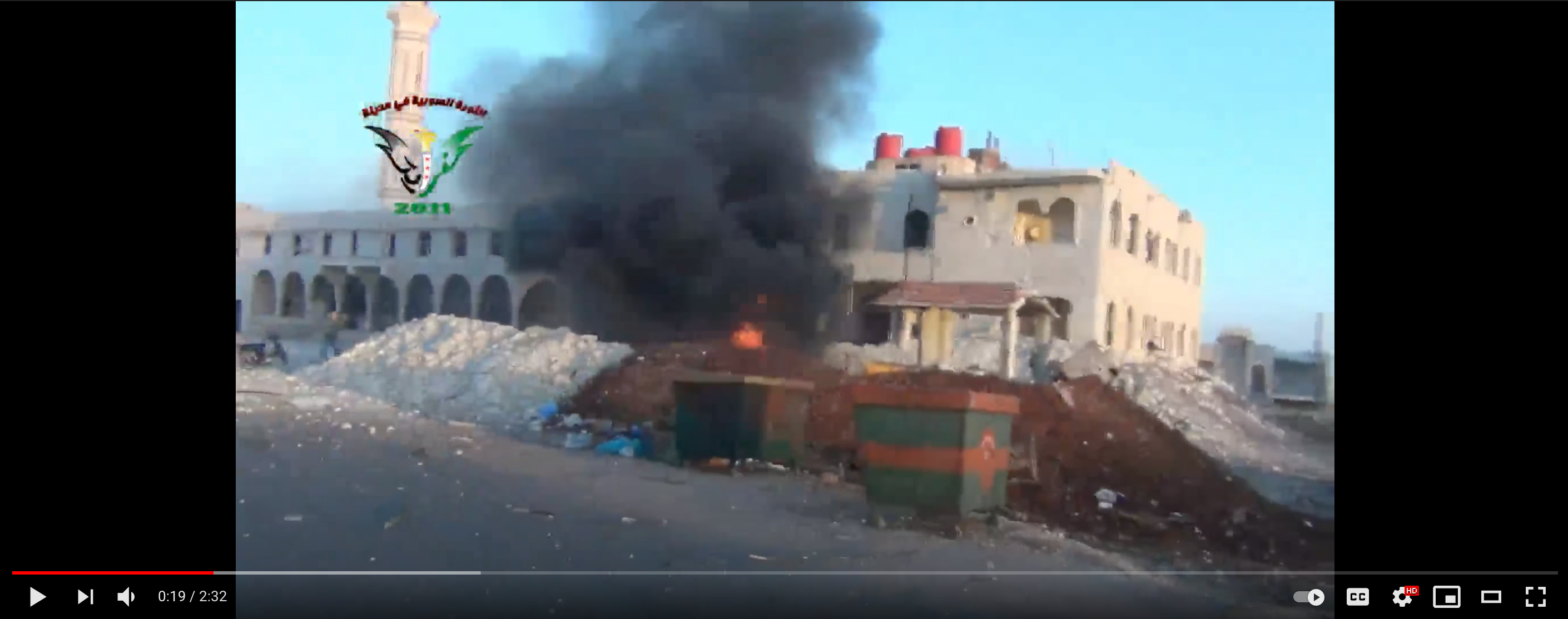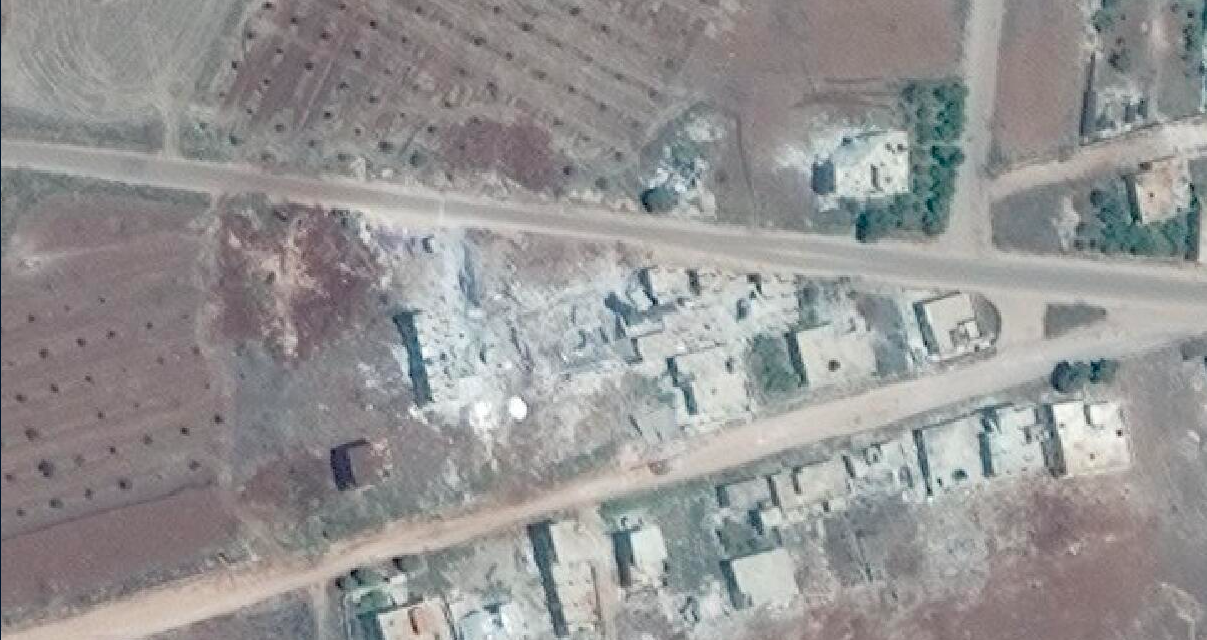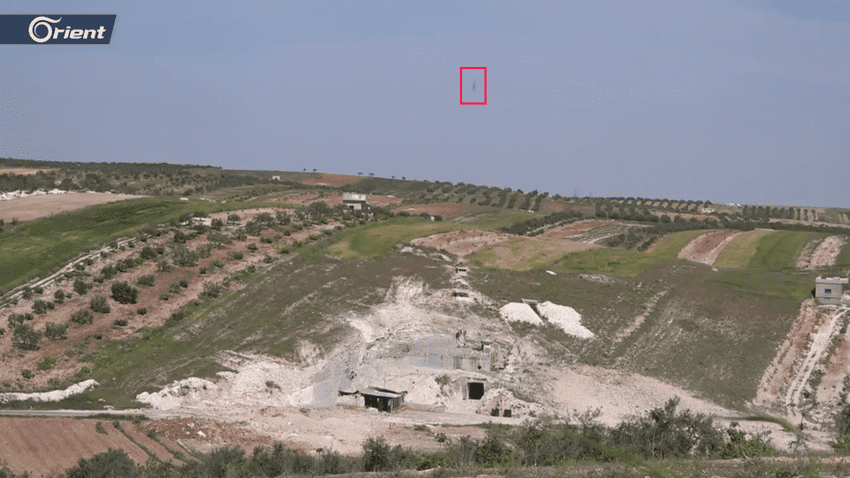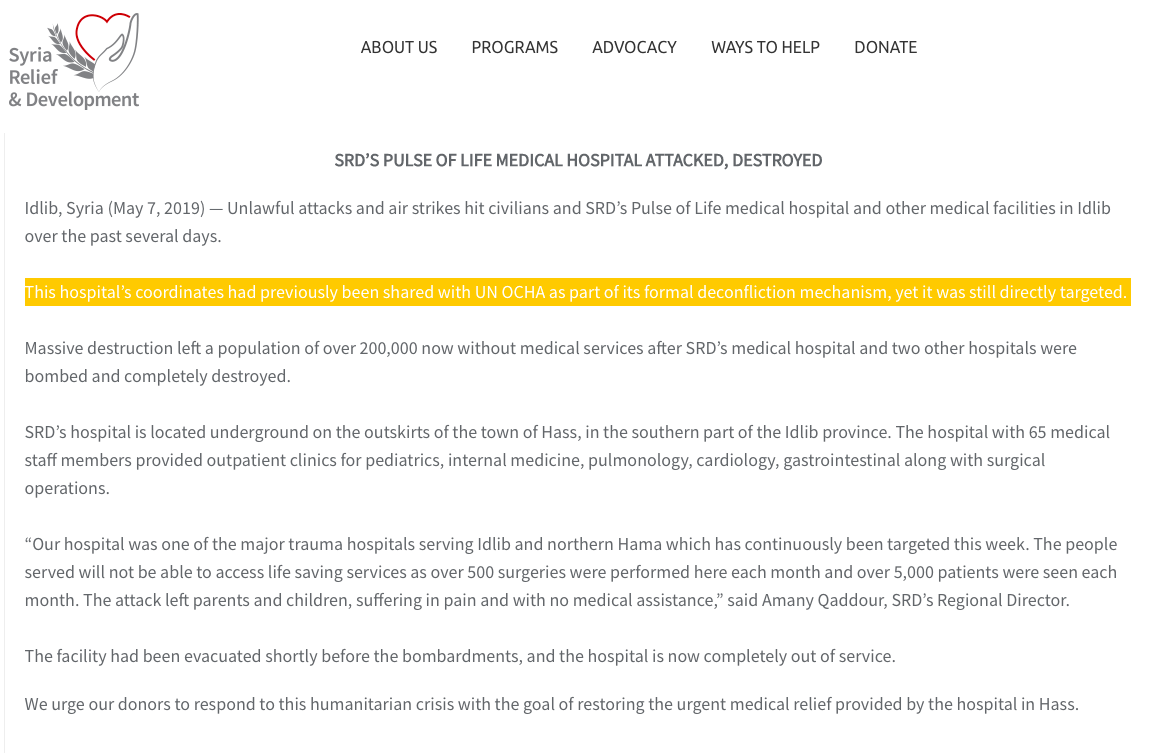FINDINGS
The right to health is a fundamental human right. Medical units, medical personnel, and the wounded or sick are all specifically protected under the international laws of armed conflict. When medical infrastructure becomes unsafe or is otherwise critically damaged, the health, safety, and livelihoods of people who rely on these facilities for essential care are seriously compromised. Without secure, reliable access to healthcare, people suffer. This is severely exacerbated in circumstances of conflict characterised by widespread, indiscriminate, disproportionate, and violent destruction―as in Syria.
Syrian Archive’s casebuilding database of visual documentation explores the intentionality, impact, and strategy of attacks against medical facilities in Syria since 2011. It documents attacks that are widespread and systematic, that are linked to the ongoing conflict, and that consistently exacerbate harm to civilians―especially to those in opposition-held areas―with the destruction of essential medical infrastructure. Many attacks against medical facilities in Syria amount to well-documented war crimes and crimes against humanity.
Since the first footage of an attack on a Syrian hospital was uploaded to YouTube on 15 August 2011, we have preserved documentation of 410 separate, verified attacks between 2011 and 2020 against a total of 270 medical facilities in Syria.
When carefully analysed and considered together, this footage clearly demonstrates that attacks against medical infrastructure in Syria is a recurring, tragic, and deliberate characteristic of the conflict.
Warning
This is a database of video documentation depicting attacks against medical facilities and medical personnel. Many of the visuals shared and much of the content analysed here are both violent and graphic.
I. Intentionality: Indicators & Targeting
Over 90%, or at least 374 of the 410, of documented attacks against medical facilities included in this database show at least one indicator of an intentional attack. To reach this estimate, we carefully analysed each incident for circumstantial indicators of attacker intent:
- Repeated attacks: repeated attacking of the same facility, over time
- Known to parties: attacks against medical facilities whose existence and location should have been known to the main parties to the conflict
- Targeted attack characteristics: attacks conducted in such a way that indicates targeting
- Clustered attacks: a pattern of attacking multiple, geographically close medical facilities within a short period of time
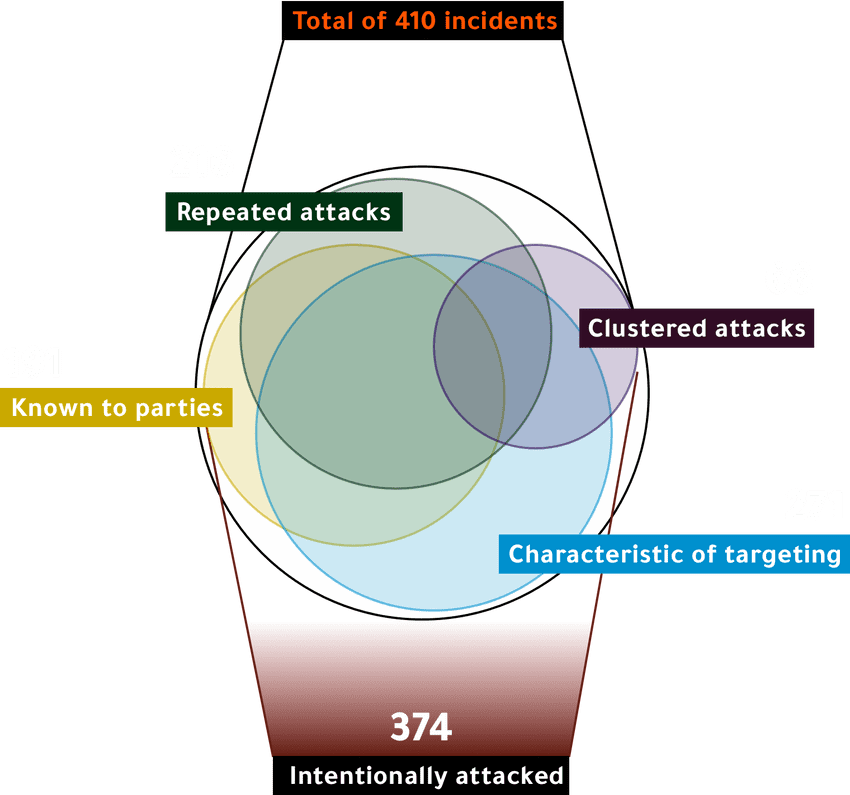
Each of these indicators may reflect different dimensions of intentionality as it is broadly understood. For instance, some may be useful as indicators of precise, targeting intent to commit the war crime of attacking a specially protected object―a medical facility. Others, especially when considered in context, may point instead to intent to impact civilian infrastructure more generally, such as by indiscriminate bombing. We leave decisions on how to use and interpret this data to the reader.
Repeated attacks
Repeated attacks on the same geographic coordinates, building structure, or facility grounds over time indicates intent for the subsequent attacks. 75 medical facilities included in this database were attacked more than once, with a total of 216 repeated attacks. 30 facilities were attacked three times or more.Example: Martyr Hassan Al Araj Hospital (or Kafr Zita Cave Hospital)
In Kafr Zita, healthcare providers responded to the mass, consistent attacks on medical facilities in the Hama countryside by building the Kafr Zita Cave Hospital in 2015, fortified by 20 metres of rock. Even so, the Cave Hospital has been attacked repeatedly ― 2 of these attacks are documented in this database.
Example: Orient Hospital in Kafranbel (or Kafranbel Surgical Hospital)
Attacks against Orient Hospital in Kafranbel have been documented 10 times: more than any other medical facility in Syria.
Known to parties
For at least 191 of the documented attacks, the main parties to the conflict―including the attack’s perpetrator―knew or should have known of the medical facility’s existence and location beforehand. For these, the medical facilities were established prior to the conflict and/or included on the ‘no strike list’ and attacked after the list was shared as part of the United Nations’ deconfliction mechanism.
More than 40% of documented attacks ― 175 of 410 ― were on medical facilities established before the conflict. Notably, Syrian Archive has collected documentation of 9 attacks against Kafr Zita Specialty Hospital and 8 attacks against Maaret Al Numan National Hospital. Both of these hospitals were established prior to the conflict.
Example: Kafr Zita Speciality Hospital in the Hama countryside
Under the deconfliction mechanism, in 2014 the United Nations shared with the United States, Russia, and Turkey the exact coordinates for the listed medical facilities under the assumption that this would help limit or stop further bombardments of medical facilities. Medical facilities included on this list continue to be attacked. The complete ‘no strike list’ is strictly confidential, so our analysis of documented attacks against medical facilities whose coordinates are included on this list is incomplete. Nevertheless, 23 of the documented attacks were on medical facilities Syrian Archive knows to have self-reported to the UN’s deconfliction mechanism.
Example: 5 May 2019 Nabd Al Hayat Hospital
The Nabd Al Hayat Hospital was attacked with an airstrike by Russian forces on 5 May 2019. A direct hit, the attack severely damaged the medical facility rendering it out of service. Syria Relief & Development, the organisation supporting the hospital, released a statement two days after the incident revealing that the hospital’s coordinates had been shared with the United Nations Office for the Coordination of Humanitarian Affairs “as a part of its formal deconfliction mechanism.” This, as described earlier, indicates prior knowledge of the facility’s exact location. Indeed, The New York Times reported audio recordings of flight traffic control and Russian warplane pilots discussing the coordinates of the hospital and confirming the 5 May airstrike on the hospital location.
Targeted attack characteristics
In at least two thirds, or 271, of documented attacks against medical facilities, the perpetrator conducted the attack in such a way that signifies unlawful targeting of a medical facility ― a specially protected object under international humanitarian law. Included in this number are all documented attacks notable for at least one attack characteristic that circumstantially indicates targeting intent, as identified through Syrian Archive’s research and data methodology. These attack characteristics are:
Direct hit. In these instances, at least one munition or missile used hit the medical facility, resulting in direct, physical impact on the structure or building being used for medical purposes.
Al Quds Hospital in Aleppo, 27 April 2016
Double tap. This is an attack tactic used to target first responders in that there are multiple, distinct strikes at strategically relevant locations and at time intervals that indicate the subsequent strikes are intended to cause harm to responding humanitarian personnel.
Field Hospital in Sarmin, 20 October 2015
Multiple targeted strikes. An attack tactic used to ensure successful targeting and maximum damage to the targeted site in that there are multiple strikes on the same coordinates or site, in quick succession.
Orient Hospital in Kafranbel (Kafranbel Surgical Hospital), 19 September 2017
Remote location. The medical facility is situated distinctly separate from main centres of population; it is not near to or surrounded by many other, unrelated (non-medical) structures.
Primary Healthcare Center in Mashmashan, 8 February 2018
Syrian Archive has also considered, as available, information on nearness of the documented attack to active fighting, or ‘Proximity to frontline.’ Greater distance from the frontline―where an attack occurred away from active fighting―can be a useful indicator and fact to consider when evaluating a perpetrator’s possible targeting of a medical facility. For many incidents under investigation, however, our researchers were unable to find precise or readily accessible information on shifting frontlines.
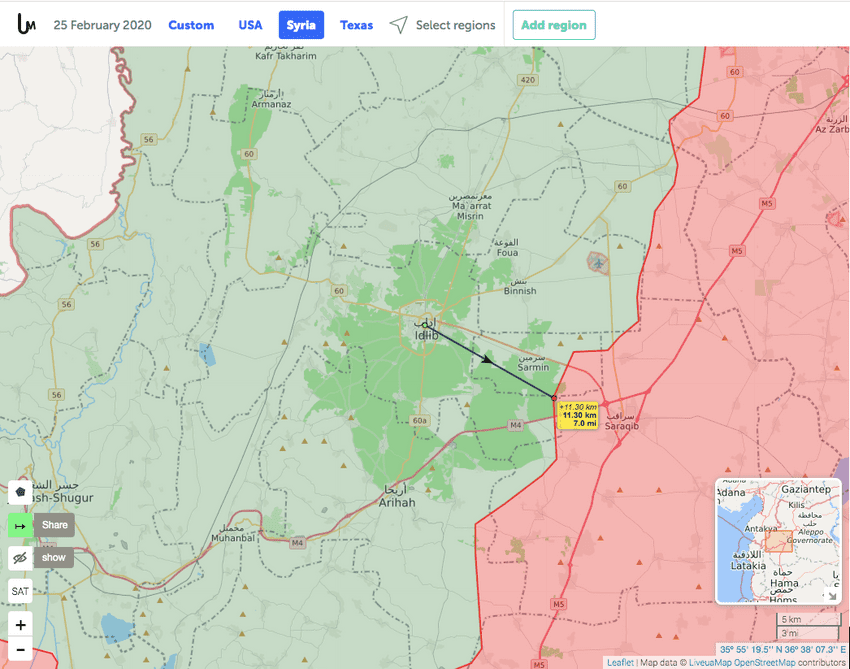
Idlib Central Hospital (Provincial), 25 February 2020
Clustered attacks
Syrian Archive identified 14 instances in which documented attacks occurred in a clustered pattern. For this analysis, we define clusters as groups of documented attacks where 2 or more medical facilities located within 10 kilometres (km) of each other are attacked within 6 days. The 14 identified clusters of attack consist of a total of 66 individual, documented attacks. The majority of clustered attacks―46 of 66 attacks―were also direct hits on the medical facility. Nearly two thirds or 43 of 66 attacks in clusters resulted in casualties.
Notably, this repeated phenomenon of clustered attacks against medical facilities may also illuminate perpetrator strategy. Namely, Russian, Syrian, or combined Russian-Syrian forces are the identified alleged perpetrators for the majority―55 of 66―of the documented, clustered attacks on medical facilities. Further, 59 of these 66 attacks occurred in opposition-held areas, with the average distance from the frontlines being calculated to be roughly 14km.. Specific instances such as the April 2017 Khan Sheikhoun attacks, described later in this report, even more directly indicate strategic, clustered targeting of medical facilities.
Example: July 2016 cluster in Aleppo city
On July 16, 19, and 23, preserved documentation confirms four airstrikes on hospitals in Aleppo city, all by the same side to the conflict: Syrian Armed Forces and Russian forces. These attacks occurred within 3 km of each other on hospitals that were previously attacked, established before the conflict, and associated with a medical organisation. The attacked hospitals were in opposition-controlled areas, less than 1.2 km away from the frontline. Moreover, these attacks occurred during an intensifying government-led siege on opposition-held areas of the city. These attacks feature characteristics—like pre-conflict establishment, repeated attacks, and clustered attacks—that indicate an intentionality behind this destruction. Reports on social media also indicate additional, undocumented attacks in Al Shaar Neighborhood against a blood bank, Al Zahra Hospital and Al Daqaq Hospital on 23 July 2016.
| July 16 | July 19 | July 23 | July 23 |
|---|---|---|---|
| Omar Bin Abdul Aziz Hospital | Al Sakhour Hospital (M10 Hospital) | Al Bayan Hospital in Al Shaar Neighborhood | Al Hakim Hospital (Children’s Specialized Hospital) |
II. Impact: Civilian Harm & Suffering
Attacks on medical facilities affect people across the country, exacerbating harm to civilians already living under armed conflict. Medical facilities attacks in Syria are widespread and have been documented in 12 of the 14 Syrian governorates. The 2 governorates without any documented attacks against medical facilities are As-Sweida and Tartous, which have remained under Syrian government control. The majority of documented attacks on medical facilities in Syria hit hospitals in the Aleppo (118) and Idlib (106) governorates.
Any time a medical facility is damaged or destroyed this causes harm to civilians impacted by the attack itself and to civilians whose fundamental human right to access health care is impeded. But Syrian Archive has documented numerous cases in which the attacks not only harmed civilians by restricting access, but also through other, compounding factors such as rendering hospitals out of service, unlawful weapons use, and attacks on hospitals serving displaced populations. In more than 95% of documented attacks against medical facilities, Syrian Archive identified circumstances, characteristics, or dimensions to the attack that likely exacerbated the resulting harm to civilians. In at least two thirds of those cases, there were two or more of these exacerbating factors. These include:
- Casualties: a death or injury to someone at the site of a documented attack, including civilians, medical personnel, and other emergency responders
- Access: instances when a documented attack rendered a hospital partially or completely out of service
- Healthcare capacity: reduction of healthcare capacity in a conflict context, which left the health services in dire condition to face a global pandemic
- Attacks on specialised care for at-risk groups: documented attacks on hospitals that treat women and children, and facilities with a focus on mental health treatments and for people with disabilities
- Links to displacement: documented attacks on hospitals serving displaced populations and instances of significant population displacement following documented attacks
- Attacks in besieged areas: documented attacks on hospitals in areas identified as under an active siege, in which civilians are affected by dwindling supplies and medical support
- Attacks in deescalation zones: documented attacks against medical facilities located inside deescalation zones, which were created in part to mitigate or alleviate harm to civilians inside these areas
- Unlawful weapons use: documented attacks with illegal or otherwise unlawfully used weapons, including chemical weapons, incendiary weapons, barrel bombs, cluster munitions, and bunker-buster bombs
- Chemical weapons clusters: instances in which one or more documented medical facility attacks occurred nearby and around the same time as one or more chemical weapons attacks
- Deconfliction mechanism: documented attacks against medical facilities which were included in the deconfliction mechanism, meaning that rather than the intended goal of protection, these facilities were likely targeted
Case study in civilian harm: Jabal Al-Zawiyeh region
The dire consequences of attacks on medical facilities for civilians are evident in the case of a collection of more than 30 villages surrounding Jabal Al-Zawiyeh, a mountain in the northeast of the Idlib region of Syria. Prior to the conflict, about 130,000 people lived in the region, accessing medical treatments in the Jabal Al-Zawiyeh villages, such as Ariha and Shanan, and relying on neighbouring communities in the region, including the larger cities of Maarat al Numan and Saraqib, for more specialised and complex hospital services. Several hospitals in the area documented by Syrian Archive were established prior to the start of the conflict, including: Al Shami Hospital and Al Majni Hospital.
Since 2011, Syrian Archive has identified more than 50 documented attacks against hospitals and medical facilities in this region alone, including specialised facilities such as an attack on Al Ikhlas Hospital for Women and Children in Shanan. These attacks frequently rendered hospitals out of service, and repeated attacks created fears among the population of seeking care at attacked facilities. By 2021, many of the hospitals had been damaged beyond usability. The Syrian government also regained control of Maarat al Numan and Saraqib, blocking civilian access to nearly 30 hospitals in those areas. Aid groups and medical organisations that had run hospitals in the region hesitate to reopen, knowing they were likely to continue to be attacked.
Even as the number of accessible hospitals reduced, flows of displaced populations from within and outside the region arrived requiring treatment. Civilians sought shelter from nearby Kafranbel or even as far as Damascus suburbs. Those displaced populations and the civilians already in the area are now reliant on just two open health facilities in Ariha, Ariha Health Centre and Nasaem Khair Center, neither of which appear to have been attacked according to the Syrian Archive database, and both of which do not offer hospital-level services. There are no longer blood banks, dialysis units, or other essential services.
As a result, some people have been forced to travel tens of kilometers to different areas in Idlib to seek treatment, while others fled to refugee camps along the Turkish border. But with the impending threat of the global Coronavirus pandemic, and a clear lack of capacity to socially-distance in the camps, displaced people are now returning to Jabal Al-Zawiyeh despite an ongoing shortage of healthcare facilities or capacity to provide Covid-19 treatment. Even with strong documentation of the existence of displaced communities in the region, hospitals continued to be attacked, exacerbating an already fraught situation for civilians.
The following characteristics demonstrating exacerbated civilian harm have been documented through testimony gathered from contacts on the ground or through data sources and Syrian Archive’s verified information. These are described in detail below, and further information on the methodology and sourcing can be found in the methodology section of the site.
Casualties
Just over half the attacks in the database ― 207 of 410 documented attacks ― resulted in confirmed casualties. There may have been more.
As defined in our research methodology, a casualty is a death or injury to someone at the site of a documented attack. For documented attacks on medical facilities, this includes medical staff, children, babies, humanitarian rescue workers, and patients undergoing surgery at the time of the attack―among many others. Notably, attackers’ use of double tap or multiple targeted strike attack strategies correlate with a significant increase in the likelihood of documented casualties from the attack. Of the 15 documented double tap attacks in this database, 13 resulted in casualties. Two-thirds, or 40 of 60, documented attacks with multiple targeted strikes resulted in casualties.
In some cases, casualties were people already injured and receiving treatment at the hospital when it came under attack. These injured people were then killed or died from additional injuries. In other cases, medical centres for people with particularly vulnerable conditions, such as those for pregnant women or for people with physical and mental disabilities were targeted, exacerbating the harm to people already requiring medical services. In many cases, these vulnerable people were killed in the attacks. For example, an attack on Shafaq Hospital for Women (Primary Health Care and Obstetrics Center) in Termanin, Idlib, featured characteristics of targeting and resulted in casualties, including injuries to babies and a pregnant woman.
Access
The ability to access healthcare is an element of the human right to health, yet numerous hospitals and medical facilities in Syria have been rendered inoperable or inaccessible. Syrian Archive identified more than 200 cases, approximately half of the documented incidents, when an attack in our database rendered a hospital reportedly out of service. Here, “out of service” means that these facilities were beyond usability: the building or medical equipment were entirely damaged, partially damaged but deemed too unsafe to access, or services were forced to be suspended for repairs, or the facility was temporarily closed for fear of further attacks. In some cases, there were political motivations to list a hospital as out of service to avoid further attacks, however this is also considered an exacerbation of harm to civilians as publicly a facility may be represented as closed, dissuading civilians from accessing crucial medical support, even if health care services were still available.
In Idlib from mid-December 2017 until mid-February 2018, Syrian Archive identified 12 documented attacks that rendered 11 hospitals or medical facilities out of service. In addition, in areas where multiple hospitals were attacked, such as during 2015 and 2016 in Aleppo, even the closure of a single hospital gravely impacted health care for civilians as the capacity to support a larger population could not exist among a smaller number of operating facilities. In some cases, such as in northern Syria in October 2019, an attack on even a single hospital or the threat of attack could result in the closure of many health facilities for fear of endangering health care workers and patients.
Healthcare capacity
Even when medical facilities were not forced to close, attacks reduced their capacity to provide services in several ways. First, through the destruction or damaging of equipment or wards, or access to electricity or water. Without these components, hospitals are unable to provide the same level of health care services as prior to the attacks. An attack on the central hospital in Idlib in the beginning of 2020 rendered the cancer ward out of service, forcing medical professionals to use other parts of the hospital for the treatment. In an investigation by Syrian Archive, verified videos showed damage to the facility. In September 2017, an attack on the Orient Hospital in Kafranbel (Kafranbel Surgical Hospital) left widespread damage. Evidence gathered and analysed by Syrian Archive reveals damage to the building itself and equipment inside.
As well, attacks on medical facilities both during sieges and in the case of repeated attacks can limit access of new supplies and create barriers that dissuade deliveries of new or required equipment and medications. As well the reduction of the number of active, accessible hospitals minimises capacity, forcing a smaller team of medical workers with less working equipment to serve larger populations, and increasingly vulnerable ones. This reduction of capacity has also led to an increasingly challenging response to the global COVID-19 pandemic, with medical facilities lacking adequate supplies such as ventilators or even functioning emergency rooms, and forced to treat larger populations in smaller or reduced capacity facilities, making it difficult to keep safe distances and protect medical workers. As Amnesty International reports: “Relatives of COVID-19 patients, medical professionals and humanitarian workers have told Amnesty International that public hospitals have been forced to turn patients away due to a lack of beds, oxygen tanks and ventilators.” A Human Rights Watch report noted the lack of personal protective equipment for health workers and that many medical facilities were working beyond capacity.
Attacks on specialised care for at-risk groups
Certain medical facilities included in this database are dedicated to serving particularly at-risk groups of people less likely to be combatants. Attacks against these specialised medical centers, then, demonstrate an incisive impact on essential healthcare services rendered to civilians in particular.
Syrian Archive identified 44 cases in which a documented attack occurred on a facility with a specialised focus on women or children, and another four against other specialised facilities such as those providing mental health care or treating people with disabilities, which are often services for civilian populations. These included maternity and children’s hospitals, such as Al Hakim Hospital (Children’s Specialized Hospital) and Omar Bin Abdul Aziz Hospital in Aleppo, Saqba Delivery Center in rural Damascus, Shafaq Hospital for Women (Primary Health Care and Obstetrics Center) in Termanin, Idlib, and the Women’s and Children’s Hospital in Al Mayadin, Deir-ez-Zor.
In one documented attack against the Specialty Center for Rehabilitation and Spinal Cord Injury Care in Douma on September 26, 2017, Syrian Archive verified videos showing people with physical disabilities, such as those in wheelchairs and unable to move to safety, within the damaged hospital facility and bearing injuries.
As well, attacks targeted hospitals providing mental health support and treatment, a crucial service in a time of conflict. A study from 2016 “estimated that approximately one in five people in post-conflict settings has depression, anxiety disorder, post-traumatic stress disorder, bipolar disorder, or schizophrenia.” It further underlined the significance of medical facilities providing mental health support services to civilians, and children are particularly vulnerable. Any attacks against such facilities could be considered exacerbating factors of harm. Another report from Action on Armed Violence said by 2013, just three mental health facilities remained operable in Syria, and one Ibn Khaldoun Psychiatric Hospital in Aleppo, had been repeatedly attacked. This is corroborated by Syrian Archive documented incidents, in which we identified a direct hit airstrike on December 25, 2012.
Links to Displacement
Displaced populations are especially vulnerable and often require increased access to health services. Of the 410 documented attacks, about a quarter of these occurred in locations known to house internally displaced populations. These were identified using United Nations publications of monthly displacement by region, and information gathered by researchers in Syria. It is likely that many other documented attacks on hospitals serving displaced communities.
A particularly notable example was an attack on a maternity hospital located in the Qah camp serving displaced populations. The hospital was established in 2019 after a previously located maternity hospital was destroyed in another attack. The Qah maternity hospital was also part of the deconfliction mechanism, meaning it was meant to be protected.
Syrian Archive also identified several cases in which there was a noticeable spike in the pattern of displacement from the region in the months following a documented attack. These were identified using United Nations estimates in monthly reporting, as well as other publications including from international NGOs, and testimonial reporting from sources in Syria. While these displacement flows are difficult to attribute solely to a factor such as an attack on a medical facility, the patterns are also corroborated by cases in which documented attacks were part of a cluster of incidents, located within an active siege, or were incidents in which there were characteristics of targeting.
In April 2017, where Syrian Archive identifies documented attacks against 8 hospitals in the Idlib governorate, the reported number of people from within that region forced to relocate within Idlib or to other areas jumped from around 6,000 people in March to more than 68,000 people the following month. Of these newly displaced people, nearly two thirds were internally displaced within Idlib.
Attacks in besieged areas
Attacks on hospitals in areas identified as under an active siege also can exacerbate harm to civilians already suffering amidst ongoing conflict and severe resource deficit. Attacking hospitals during a siege can reduce further capacity and resources, as the conflict often contributes to dwindling supplies and medical support through transportation restrictions and other shortages. While not itself illegal under the international law of armed conflict, any use of siege warfare must abide by all relevant rules, articulated to limit war’s destructive effect and mitigate human suffering.
Syrian Archive identified 83 incidents which occurred during a siege, nearly one fifth of documented attacks. This data was gathered using reports from siege-tracking organiSations such as Siege Watch as well as other reports and historical documents to corroborate the occurrence of a siege at the time of the documented attack.
One example of attacks during an ongoing siege occurred during 2016 in the eastern side of Aleppo. Syrian Archive identified 26 documented attacks against hospitals and medical facilities in the besieged areas of Aleppo between January 1, 2015 and December 22, 2016, at which point the city was nearly emptied of civilians. The repeated and direct hit attacks rendered all but one medical facility, Al Quds Hospital, out of service. Syrian Archive identified one final attack on Al Quds on 27 April 2016, in which medical equipment was damaged, and video shows attempts to rescue injured people from within the destruction. In a time of active siege, when equipment and supplies are dwindling and resources are not able to enter the area, the destruction of medical facilities and equipment such as the documented attack on Al Quds further exacerbates harm to civilians.

As reported by Independent International Commission of Inquiry on the Syrian Arab Republic: “The methods employed in Syria to carry out sieges have amounted to egregious violations of international human rights and humanitarian law and, in some instances, to war crimes. They have repeatedly been carried out in a deliberate, coordinated, and systematic manner, in further violation of prohibitions established under customary international law, and in flagrant disregard for human rights principles and in violation of international criminal law.”
Attacks in Deescalation Zones
Deescalation zones in Syria were established on 4 May 2017 in a memorandum of understanding signed by Russia, Turkey, and Iran. With zones situated around Idlib, northern Homs, eastern Damascus, and Daraa, the agreement sought to limit violence and civilian harm.
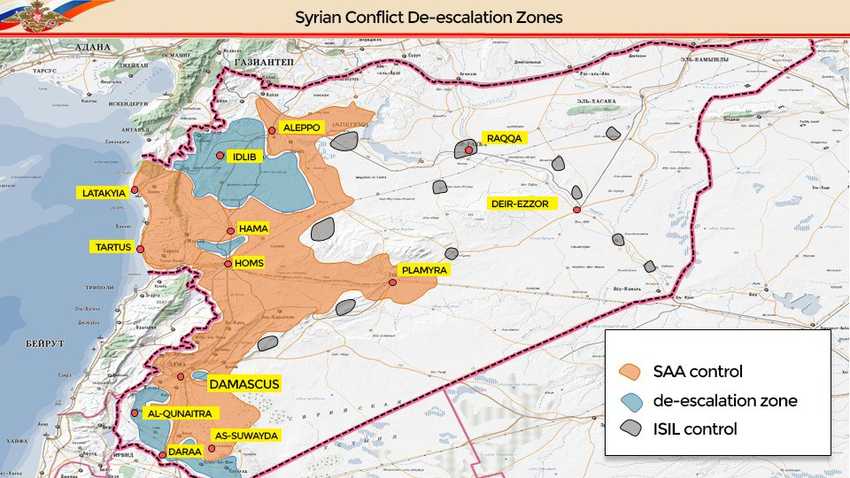
Originally published by the Russian Ministry of Defense. Translation here.
The majority of documented attacks after May 2017 ― 50 out of 85 ― were against medical facilities located inside a deescalation zone. The 50 documented attacks inside these established safe zones demonstrate plain disregard for an international agreement intended to reduce violence and civilian harm. Indeed, 34 of these 50 documented attacks were direct hits on medical facilities and 28 resulted in casualties. Notably, Syrian Archive can also confirm that most of these documented attacks ― 43 of 50 ― were very likely carried out by Russian and/or Syrian forces.
Unlawful weapons use
Unlawful weapons use has been documented in at least 32 attacks against medical facilities in Syria since 2011. Generally speaking, use of certain weapons is specifically outlawed or otherwise becomes unlawful in armed conflict when it causes disproportionate harm or suffering to civilians or civilian objects. Unlawful weapons use in attacks against medical facilities, then, almost certainly compounds the harm to civilians from destruction of this essential specially protected object.
Use of chemical weapons is plainly illegal by the Chemical Weapons Convention (art. 1). The two documented uses of chemical weapons against medical facilities ― Al Sakhour Hospital (M10 Hospital) and Al Lataminah Surgical Hospital ― were by the Syrian government and occurred in 2016 and 2017 respectively, after Syria’s accession to the Chemical Weapons Convention.
Customary law of armed conflict obliges parties to take all feasible precautions against civilian harm when conducting an attack. Given their imprecision and large explosions, use of barrel bombs in densely populated areas ― estimated under the rules of our database as instances of a medical facility that is not remotely located ― is almost certainly unlawful. In this database, there are 25 documented barrel bomb attacks against medical facilities that are not remotely located. The large-scale destructiveness of barrel bombs very likely made exercising the required distinction between civilians and any legitimate military targets present in the attack area impossible for the attackers in these 25 documented instances. Even if a valid military target could be identified, any use of barrel bombs in densely populated areas would likely be considered unlawful due to its disproportionate risk to civilians and civilian objects. Further, in certain instances documented uses of barrel bombs in densely populated areas may have amounted to area bombardment, also prohibited by customary law of armed conflict.
Similarly, use of cluster munitions is commonly unlawful insofar as they are imprecise by nature and cause immediate, wide-ranging destruction. Given this, the perpetrators of the 7 documented cluster munitions attacks against medical facilities in Syria almost certainly did not take the required precautions, exercise the required discretion, or properly evade disproportionate harm to civilians and civilian objects. Beyond this, however, cluster munitions are known to have high dud rates, making their unexploded submunitions exceedingly dangerous and ― in effect ― indiscriminate, de facto landmines.
The Protocol on Prohibitions or Restrictions on the Use of Incendiary Weapons prohibits the use of incendiary weapons if “air-delivered…against a military objective located within a concentration of civilians” (art. 2(2)), meaning within “any permanent or temporary concentration of civilians, such as the inhabited parts of cities, inhabited towns or villages, camps, columns of refugees or groups of nomads” (art. 1(2)). This protocol is part of the Convention on Certain Conventional Weapons that are known to be “excessively injurious or to have indiscriminate effects.” Notably, while most state parties to the Syrian conflict including Russia, the United States, and Turkey have ratified this treaty, Syria has not. Regardless, the treaty language reflects the likely application of customary law of armed conflict―again grounded in the principles of precautions, discretion, and proportionality―which binds all parties to the conflict. There are 4 documented uses of incendiary weapons in attacks against medical facilities in Syria. All but one of these documented uses of incendiary weapons were airstrikes against medical facilities that were not remotely located.
In the single documented use of a bunker-buster bomb included in this database, the impacted facility ― Al Sakhour Hospital, or M10 Hospital ― was designed for protection from aerial bombardment by tunnelling to construct underground facilities. The use of a bunker-buster bomb, built to penetrate well-fortified structures deep underground, strongly indicates intent to destroy the specially protected medical facility.
Medical-chemical attack clusters
Syrian Archive has identified 46 instances in which one or more documented medical facility attack occurred nearby and around the same time as one or more chemical weapons attack. This pattern of attack severely diminishes local medical capacity to provide effective care to victims of chemical attacks. Syrian Archive was unable to identify for each instance of medical-chemical clustered attacks whether the nearby and attacked medical facilities were used to treat victims of chemical attacks. However, the significant number of medical-chemical clusters―at least 46 documented―indicate a pattern of attacking medical facilities before, after, or during unlawful, medically harmful chemical weapons use. Any strategy of targeting medical care providers that are close in time and in location to a chemical weapons attack is one that would almost certainly exacerbate suffering and worsen already drastically poor living conditions in civilian-populated areas.
These 46 clusters include, in total, 77 chemical weapons attacks* and 68 documented hospital attacks, each of which occurred within 0-10 days of at least one, nearby chemical weapons attack. “Nearby” medical facilities were on average 10 km away from a chemical weapons attack. Our data shows that an estimated 56 of the medical facilities attacked in a cluster with a chemical attack were intentionally attacked.
Example: Khan Sheikhoun medical-chemical cluster
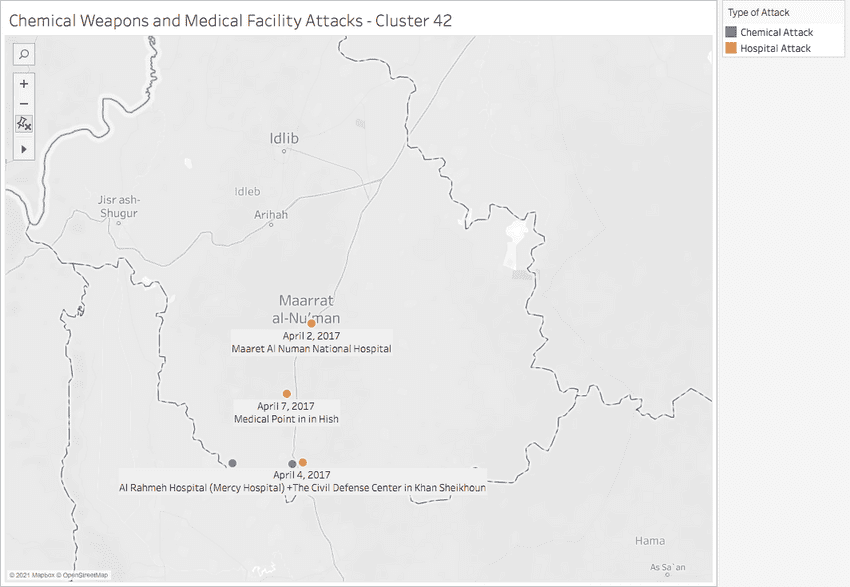
On 4 April 2017, Syrian government forces attacked Khan Sheikhoun village with Sarin gas, killing 98 people and injuring 300 others. That same day ― 4.5 hours later ― Syrian government or Russian forces hit the nearby Al Rahmeh Hospital with 9 airstrikes. Two other nearby hospitals were also attacked in the area: Maaret Al Numan National Hospital on 2 April 2017 and a medical point in Hish on 7 April 2017. Staff at Maaret Al Numan National Hospital have described it as: “the main hospital in the area and the one which could have more adequately dealt with cases of patients exposed to chemical agents” had it not been damaged in the days prior.
Example: Saraqib medical-chemical cluster
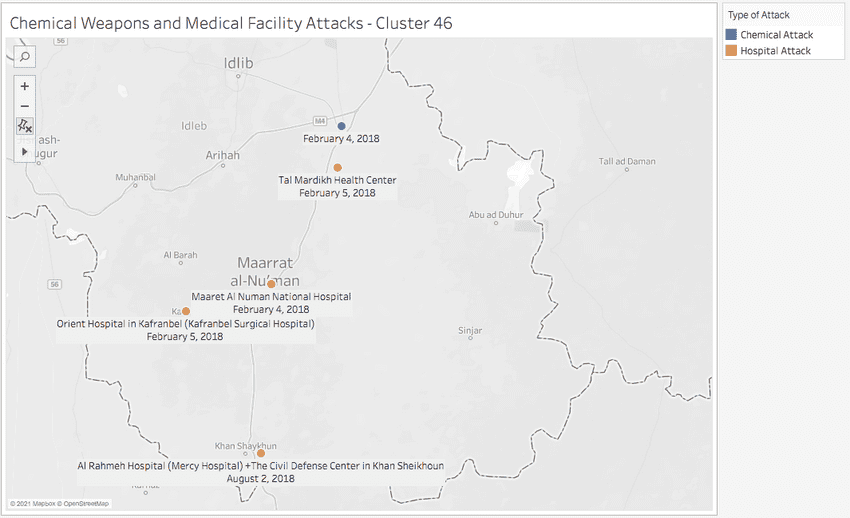
On 4 February 2018, the Syrian government launched a chlorine gas attack against Saraqib, a city in Idlib. That same week, there were 4 documented attacks on medical facilities situated near to Saraqib, along the main, M5 Aleppo-Damascus highway.
Deconfliction mechanism
An additional exacerbating factor of harm against civilians resulted from targeting hospitals or medical facilities which were specifically designated for protection, garnering a false sense of safety for those seeking treatment. Syrian Archive identified 23 documented attacks on facilities known to have self-reported to the United Nations’ deconfliction mechanism, with the intended goal of protection.
For example, Syrian Archive has collected and preserved footage of an attack on Al Rastan Field Hospital in Homs on 30 April 2018. The hospital was known to parties and was identified as having self-reported to the deconfliction mechanism.
III. Strategy: Perpetrator Analysis in Context
Syrian Archive identified with confidence the perpetrator for more than two thirds or 280 of the 410 documented attacks on medical facilities in the database. Of these, Syrian government and Russian forces—either independently or in coordinated action—are identified as the alleged perpetrators for 90%, or 252 documented attacks. Other parties to the conflict including opposition groups, pro-government militias, Turkish Forces, the Islamic State, the U.S.-led international coalition, and the YPG/ PYD -SDF were identified as the alleged perpetrators for 28 documented attacks on medical facilities.
For the predominant perpetrator group of Russian and Syrian government forces, deliberate targeting to impact harm is an apparent underlying strategy of the repeated, frequent, and widespread attacks against medical facilities in Syria since 2011. As attested in a report to the United Nations Human Rights Council, “the pattern of attacks indicates that [Syrian] Government forces deliberately targeted hospitals and medical units to gain military advantage by depriving anti-Government armed groups and their perceived supporters of medical assistance.” And yet, under Syria’s constitution: “the state shall protect the health of citizens and provide them with the means of prevention, treatment and medication” (art. 22(2)).
The following tactics and patterns of attack―illustrated by documented examples from the database ― demonstrate this underlying strategy.
Anti-terrorism narratives & official denials
Early in the conflict, on 2 July 2012, the Syrian government enacted anti-terrorism laws that effectively ― and unlawfully ― criminalised provision of medical aid to anyone the Syrian government identifies as an opposition member. The reported result: “government intelligence and law enforcement agencies have forcibly disappeared medical personnel providing treatment to perceived opposition supporters.” By this logic, government and government-allied attacks against medical facilities in opposition-held areas, too, may simply be considered in line with the so-called anti-terrorism law. Indeed, requests for government approval to operate medical facilities in opposition-held territory were ignored, which in practice made the operation of any opposition-held hospitals illegal.
Approximately 90% of Syrian forces’ documented attacks against medical facilities were directed against areas under opposition control. Of these, Syrian Archive estimates that 95% were intentionally attacked.
Perpetrators’ statements of denial demonstrate the use of anti-terrorism laws to justify attacks on medical facilities and other civilian infrastructure. Russian forces, for example, have utilised Syrian government rhetoric and anti-terrorism laws to deny or justify attacks on medical facilities.
Case Study: Field Hospital in Sarmin
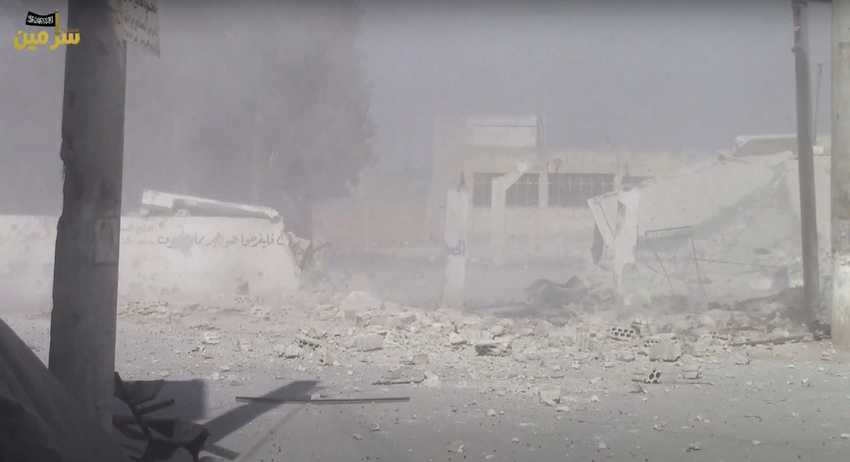
Damage to a nearby school, after Russian forces targeted a field hospital in Sarmin.
On 20 October 2015, Russian forces allegedly hit a field hospital in Sarmin with multiple airstrikes, resulting in casualties. The attack also damaged a school directly across from the targeted facility. Russian forces allegedly hit the area in a double tap attack, killing civilians and first responders arriving at the scene to rescue victims.
In response to accusations about these actions, the Russian Ministry of Defense released a statement on the airstrike. Titled “In the course of the last two days, the aircraft of the Russian air group in the Syria have been making strikes against uncovered infrastructural facilities of the ISIS and Jabhat al-Nusra terrorist groupings,” the statement denies claims of an attack on the facility, incorrectly citing no visible damage to the hospital from satellite imagery or the nearby street, and implicates terrorist groups in an apparent effort to legitimise the attack.
Syrian Archive has not discovered any information credibly indicating the presence of military objectives, defined as “objects which by their nature, location, purpose or use make an effective contribution to military action and whose total or partial destruction, capture or neutralisation, in the circumstances ruling at the time, offers a definite military advantage”, at this time and location.
This field hospital was, however, situated within an opposition-held area and therefore fell under the Syrian government’s anti-terrorism law.
Additional examples of denial by perpetrator:
| Hospital Name | Date of Attack | Perpetrator | Statement |
|---|---|---|---|
| Al Sakhour Hospital (M10 Hospital) | 1 October 2016 | Combined Syrian and Russian Forces | Denial by Russian Ministry of Defense |
| Al Sakhour Hospital (M10 Hospital) | 3 October 2016 | Syrian or Russian Forces | Denial by Russian Ministry of Defense |
| MSF Hospital in Maaret Al Numan | 15 February 2016 | Russian Forces | Denial by Russian Ministry for Defense |
Endangering hospitals with military presence
In its September 2013 report, the United Nations Human Rights Council describes a strategy of Syrian government forces “placing military objectives in hospitals” by using these locations for “sheltering able-bodied combatants, storing arms or ammunition, [or] as military observation posts or shields for military action.” When used, this tactic endangers these essential healthcare facilities, making them possible ― and lawful ― targets for attack, constituting “a failure to take all feasible precautions to protect civilians from the effects of [military] attack.”
Syrian Archive identified 5 documented instances of Syrian Armed Forces attacking and occupying medical facilities with boots on the ground. Ground attacks by combatants create a strategic military presence at the medical facility and result in loss of protection for that civilian object, even if only temporarily.
| Hospital Name | Governorate | Date of the Attack | Casualties |
|---|---|---|---|
| Al Rayes Hospital (Al Hourani Hospital) | Hama | 1 August 2011 | Unknown |
| Al Rayes Hospital (Al Hourani Hospital) | Hama | 22 August 2011 | Unknown |
| Al Raja Surgical Hospital | Rural Damascus | 1 February 2012 | True |
| Hamdan Hospital | Rural Damascus | 29 June 2012 | True |
| Al Hasan Hospital | Rural Damascus | 18 August 2012 | Unknown |
The majority of documented ground attacks by Syrian government forces against medical facilities occurred in 2011 and 2012, specifically in the Rural Damascus and Hama governorates. Two of the attacks resulted in casualties. Of these five incidents, Al Rayes Hospital (or Al Hourani Hospital) was attacked twice by ground.
Example: Al Rayes Hospital (Al Hourani Hospital)
Scenes from the 1 August 2011 raid on Al Rayes Hospital by Syrian government forces.
Syrian Armed Forces raided Al Rayes Hospital on 1 August 2011. Collected footage shows government soldiers approaching with weapons and surrounding the facility. Human Rights Watch reports this tactic as frequently used by government forces on the hospital to scare patients and hospital staff treating protesters. On 5 July 2011, for example, Human Rights Watch determined that “the Syrian army surrounded the Hourni hospital […] scaring many of those who had assembled around the hospital, but did not enter the facility or arrest any of the wounded there.”
In the case of the 1 August raid however, videos show destroyed hospital equipment, fires, bullet holes in windows, and shrapnel/bullet casings scattered on the hospital’s floor. Visual information suggests that rather than scaring hospital staff and patients the facility was raided to harm those within the hospital. Syrian Armed Forces attacked Al Rayes Hospital again later in 2011. Footage from this later attack shows similar damage to the facility.
Syrian government military presence at Al Rayes Hospital, 1 August 2011
Incidents, such as the 28 May 2019 attack on Dar Al Hikma hospital in Kafranbel, reveal an additional strategy of the Syrian government constructing and then utilising nearby military infrastructure to attack medical facilities.
Use of a military presence to endanger medical facilities has not been limited to Syrian government forces, however. We have identified 6 instances of similar ground attacks on medical facilities by opposition forces as well as 1 each by the YPG/ PYD -SDF and a pro-government militia. In all cases, such tactics endanger healthcare centers operating in armed conflict and their ability to provide essential medical services to civilians in the area.
Same-day targeting
Same-day targeting of multiple medical facilities by one perpetrator group or the same side to the conflict exemplifies both the intentionality and the systematic nature of this overall strategy of attacking medical facilities during the Syrian armed conflict. Syrian Archive has identified 6 instances of an observable attack pattern in which Syrian and/or Russian forces apparently intentionally attacked multiple medical facilities within the same governorate, on the same day. In other words, each of the identified, clustered attacks reflect one or more indicators of an intention to specifically target medical facilities on that day.
| Date | Location | Medical Facility Name | Alleged Perpetrator | Targeting Indicator | ||||
|---|---|---|---|---|---|---|---|---|
| Direct hit airstrike | Double tap | Multiple targeted strikes | Remote location | Established pre-conflict | ||||
| 16 October 2015 | Aleppo | Al Hadir Hospital | Syrian and/or Russian forces | X | X | |||
| Al Eis Field Hospital | Russian forces | X | X | |||||
| 15 February 2016 | Idlib | Maaret Al Numan National Hospital | Syrian forces | X | X | |||
| MSF Hospital in Maaret Al Numan | Russian forces | X | X | X | ||||
| 23 July 2016 | Aleppo | Al Bayan Hospital in Al Shaar Neighborhood | Syrian forces | X | ||||
| Al Hakim Hospital (Children’s Specialized Hospital) | Syrian and/or Russian forces | X | X | |||||
| Al Atarib Hospital | Russian forces | X | ||||||
| 14 November 2016 | Aleppo | Al Ansar “Beauty” Hospital in Urem Al Kubra | Combined Syrian and Russian forces | X | ||||
| Al Atarib Hospital | Russian forces | X | X | |||||
| Baghdad Hospital in Oweijel | Russian forces | X | X | |||||
| 19 September 2017 | Idlib | Al Rahmeh Hospital in Khan Sheikhoun | Russian forces | X | ||||
| Orient Hospital in Kafranbel (Kafranbel Surgical Hospital) | Russian forces | X | X | |||||
| Al Rahman Hospital in Tah | Russian forces | X | X | X | ||||
| 5 May 2019 | Idlib | Nabd Al Hayat Hospital (Hass Hospital) | Russian forces | X | X | X | ||
| Orient Hospital in Kafranbel (Kafranbel Surgical Hospital) | Russian forces | X | X | X | ||||
| Tramla Specialist Hospital | Syrian forces | X |
Stalking medical care
Stalking medical care is the repeated attacking of medical services providers located near each other―often in the same city or village, with overlapping service areas ― until they are all inoperable or out of service. This pattern of attacks severely limits access to medical care, impacting the living conditions of all people within affected areas.
To mitigate this destructive pattern of attacks, healthcare workers and medical organisations have taken protective measures, including: publicly posting that a facility is no longer in service with the hope of dissuading additional attacks against it; tunneling under or moving services to the basements of existing hospitals to create structurally reinforced areas for care or shelter; or building new, more protected medical facilities in new locations by tunneling into caves or mountainsides. Such protective measures, however, have been followed by documented and reported escalations in the destructive tactics employed by the attacking party, such as by use of bunker-buster bombs and/or chemical weapons in attacks allegedly by Syrian government and Russian forces against underground or otherwise fortified medical facilities.
Example: Countryside area between Idlib and Hama
Syrian Archive identified repeated, documented attacks on three medical facilities located within 25 km of each other. Due to the repeated attacks, all of these facilities were at times forced out of service:
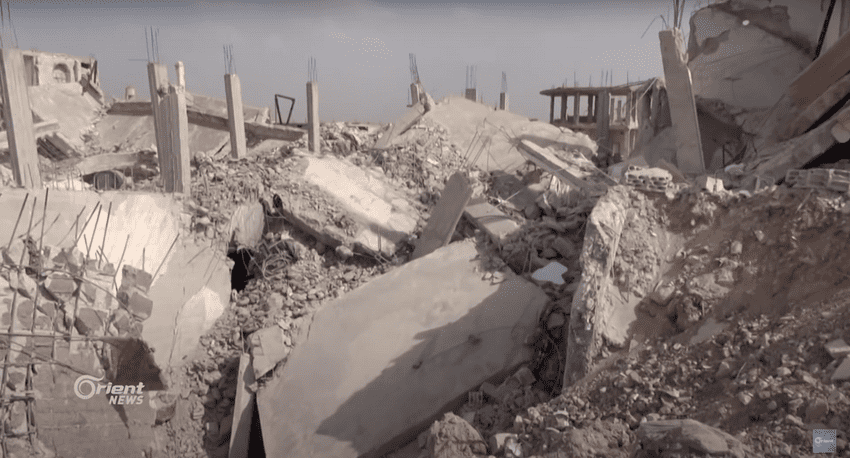 Kafr Zita Speciality Hospital after Russian Forces attacked the hospital on 5 February 2018.
Kafr Zita Speciality Hospital after Russian Forces attacked the hospital on 5 February 2018.
Kafr Zita Speciality Hospital is the second-most attacked facility in this database. There have been 9 documented attacks on this hospital, each causing temporary disruptions to service between 2014 and 2018 before eventually pushing the facility entirely out of service. All of these documented attacks were airstrikes allegedly by Syrian or Russian Forces; the hospital was hit four times by barrel bombs. Especially given that the facility was established before the conflict and was repeatedly attacked, it is likely that the facility was deliberately targeted by perpetrators in these attacks. In response to these frequent attacks, the hospital publicly reported itself as “out of service” while covertly continuing operations between 2014 and 2018 in hopes of dissuading would-be attackers. Eventually, the medical facility moved underground. Footage from as early as 2016 shows a concrete tunnel to enter the hospital. A report by The Syria Campaign in partnership with medical organisations in Syria ― “Saving Lives Underground” ― featured interviews with doctors working at the hospital. Dr. Hassan Al Araj reportedly initiated the construction of the Kafr Zita Cave Hospital in response to repeated attacks on Kafr Zita Speciality Hospital.
Martyr Hassan Al Araj Hospital (or Kafr Zita Cave Hospital) was built to withstand damage, fortified by 20 metres of rock. According to the UOSSM, the hospital served around 7,000 patients a month. Russian forces allegedly attacked the hospital twice in early 2018. For both attacks, the facility was directly hit by airstrikes and likely deliberately targeted. The Syrian American Medical Society (SAMS), an NGO supporting the medical facility, reported the hospital as at least temporarily out of service after the second, 1 February 2018 attack. Built in response to repeated attacks on medical facilities in the area, the hospital often reported itself out of service in an attempt to prevent additional attacks. However, Syrian Archive has interviewed witnesses who report seeing government troops enter the facility after the February 2018 attack. Russian news reports show Russian forces entering and destroying the hospital on March 1, 2021.
There have been 10 documented attacks between 2014 and 2019 on Orient Hospital in Kafranbel (or Kafranbel Surgical Hospital), of which Syrian government or Russian forces were allegedly responsible for at least 8. Targeting characteristics indicate that the facility was deliberately targeted in all of these documented attacks. In May 2019 the hospital was rendered “completely destroyed and inoperable,” according to the United Nations Commission of Inquiry. Serving over 200,000 patients while in service, the Orient Hospital moved its operations underground between 2018 and 2019. Video from this time shows a concrete tunnel leading to an underground portion of the facility.
Sieges: “Draining the Sea to Kill the Fish”
Called “surrender or starve” and tansheef al bahr (“draining the sea to kill the fish,” as it has been described by victims of this strategy), this is a near-cyclical, seige-based military tactic that has been repeatedly employed ― mostly by Syrian government forces ― in an apparent effort to compel the area’s controlling party. As reported by the Independent International Commission of Inquiry on the Syrian Arab Republic, the observed pattern involves:
(a) the encirclement of an area, including the setting up of checkpoints at all access points
(b) the imposition of a siege, including preventing the flow of food, medical supplies, and sometimes water and electricity, into the town or area
(c) the shelling and aerial bombardment of the besieged area
(d) the arrest, and often disappearance, of wounded persons attempting to leave the besieged area to seek medical treatment no longer available inside and of those attempting to break the siege, usually by smuggling in food and medical supplies
Part of this pattern of attack is intentional targeting of medical supplies, medical care providers, and medical facilities. Dr. Anita Gohdes, professor of International and Cyber Security at the Hertie School, said this pattern of attack identified is part of a collective targeting strategy she has seen employed by the Syrian government: “As part of laying siege to an area, the government has been known to cut access to basic necessities while simultaneously subjecting these areas to aerial bombing and shelling. In this context, the targeting of medical facilities follows the strategic goal of a siege tactic aimed at denying the population access to basic human services.”
And so, integral to the apparent strategy is the inhumane motivation that under regular bombardment and without access or availability of medical care, civilians and armed combatants alike who are living within the besieged areas are subjected to extreme suffering that leads to surrender of territory control.
A comprehensive, mapped, and publicly available timeline of sieges in Syria does not exist. However, Syrian Archive data shows Syrian government and Russian forces conducting attacks on medical facilities in Damascus, Rural Damascus, and Aleppo between 2012 and 2018 that severely restricted or entirely eliminated access to medical treatment while these areas were under siege. At least 83 hospital attacks documented in this database occurred during a siege.
Of these, Russian or Syrian government forces were allegedly responsible for 52 attacks with an overwhelming 34 attacks by these forces resulting in casualties. Russian and Syrian government forces repeatedly attacked 8 of the hospitals underscoring likely intent to exacerbate the already poor conditions of civilians in siege areas.
In an Amnesty International report on the siege of the Yarmouk Camp in Damascus, testimonies gathered by researchers describe frequent targeted attacks on the hospitals and medical staff in the camp to severely diminish the capacity and services of medical facilities. Within this camp alone, Syrian Archive has preserved documentation of 4 attacks on Palestine Hospital and 2 attacks on Al Basil Hospital during sieges.
Alongside targeted attacks, reports from the Office of the United Nations High Commissioner for Human Rights additionally detail Syrian government forces preventing medical evacuations during sieges when hospitals were destroyed or no longer in operation. Consistent with other patterns of attack in the database, attacks on medical facilities during sieges demonstrates a perpetrator strategy of leveraging attacks on medical facilities during military operations and offensives to exacerbate civilian harm.
Medical-chemical attack clusters & military offensives
In its April 2020 report on the March 2017 chemical weapons attacks on the village of Al Lataminah, the Organisation for the Prohibition of Chemical Weapons notes that the use of chemical weapons attacks by the Syrian government “would not be inconsistent with a [military] strategy aimed at inflicting terror on both civilians and combatants, at eliminating infrastructure such as the medical facilities required to continue fighting, and at ensuring that no one felt safe even behind the front lines proper.” According to the Global Public Policy Institute, almost all documented chemical attacks are attributable to the Syrian government.
Syrian Archive has identified attacks on medical facilities occurring near in time and space to chemical weapons attacks, during government military operations. This further confirms the use of a deadly combination of chemical weapons attacks with attacks on medical facilities in government military strategies. When comparing the number of hospital and chemical weapons attacks by week, data shows periods where both attacks took place within a context of perpetrator led offensives to retake targeted regions.
Our data reveals simultaneous spikes in the general number of medical facility and chemical weapons attacks at around the same time and in the same general location as large military offensives. In 88 non-consecutive weeks where at least one hospital attack occurred the same week as a chemical weapons attack, the data shows a Syrian government strategy in utilising a combination of both types of attacks to advance its offensives.
Example 1: March - June 2015
March - June 2015 — where chemical weapons attacks and hospital attacks occurred on the same week for a total of 16 non-consecutive weeks — saw a spike in the number of hospital and chemical weapons attacks with around 2 hospital attacks and 5 chemical weapons attacks per non-consecutive week. The majority of these attacks were on towns and hospitals in the Idlib governorate and were allegedly committed by the Syrian government. Looking to the broader conflict context, these attacks were most likely a Syrian government response to a rebel-led offensive to retake the governorate and specifically Idlib city.
Example 2: June - December 2016
June - December 2016 — where chemical weapons attacks and hospital attacks occurred on the same week for a total of 13 non-consecutive weeks — saw a spike in hospital and chemical weapons attacks with 3 hospital attacks and 2 chemical weapons attacks happening on average per non-consecutive week. All these attacks during this period occurred specifically around Aleppo city. Syrian Archive identifies Russian and Syrian forces as the perpetrators for the majority of the 36 medical facility attacks. Given the time and location of these incidents, they were most likely part of a Syrian government offensive to retake Aleppo city.
Indiscriminate bombing of civilian infrastructure
While targeted and apparently strategic attacks against medical facilities in Syria cause extreme suffering and create unlivable circumstances for civilians, indiscriminate bombing of densely populated areas in Syria is also intentional, strategic, clearly unlawful, and consistently done. In a March 2015 statement, the chair of the Independent International Inquiry on the Syrian Arab Republic described indiscriminate bombings of civilian areas as a “major component of the Syrian State forces strategy in the on-going conflict.”
Syrian Archive has identified at least 53 documented instances of medical facilities impacted by indiscriminate bombing campaigns. In this estimate we include attacks perpetrated by Syrian government or Russian forces and characterised by at least one of the following contextual indicators of indiscriminate bombing:
- Use of inherently indiscriminate weapons: cluster munitions, barrel bombs, or chemical weapons.
- Multiple medical facilities in the immediate area—for example, hospitals all within a few blocks of each other, in the same city neighborhood—attacked on the same day.
- Other, nearby protected people and objects—bakeries, markets, religious structures, schools, or water sources—also impacted in the same, documented attack.
We then examined each of these attacks with circumstantial indicators of indiscriminate bombing campaigns in context, corroborating and confirming the finding with reports on conflict activities in the area of attack at that time as well as excluding any medical facilities not tightly situated within densely populated civilian areas.
“Previous evidence suggests that the extensive use of aerial bombardments and shelling, while indiscriminate in their immediate impact, has repeatedly been used to target centers of civilian activity. The reports evidence of repeated, widespread attacks that have led to civilian suffering further confirm the intentional use of violence against civilians and civilian infrastructure,” according to Dr. Anita Gohdes, professor of International and Cyber Security at the Hertie School.
The data shows Syrian and Russian forces used indiscriminate weapons — cluster munitions, barrel bombs, and chemical weapons — in at least 38 of these attacks against medical facilities. In a 22 April 2017 attack impacting Abdin Hospital in Idlib, for example, Russian forces allegedly used cluster munitions, resulting in injuries to medical staff and forcing the hospital out of service.
Filmed from Al Hakim Hospital in Al Shaar neighborhood of Aleppo city on 14 November 2016
Syrian Archive additionally identified 3 documented incidents of multiple facilities attacked around the same date and location. For example, the week of 14 November 2016, at least two hospitals in the Al Shaar neighborhood of Aleppo — the Al Bayan Hospital and Al Hakim Hospital (Children’s Specialized Hospital) — were attacked by Russian or Syrian government forces. This occurred during a large-scale Syrian government offensive to retake parts of the city.
Lastly, 11 documented attacks allegedly by Syrian and Russian forces impacted not only medical facilities but also other protected people and objects: markets, bakeries, schools, or religious structures. On 20 October 2015, Russian forces allegedly hit a field hospital in Sarmin in multiple airstrikes that also damaged a nearby school. The double tap attack resulted in casualties, killing and injuring hospital staff and Civil Defense volunteers.
